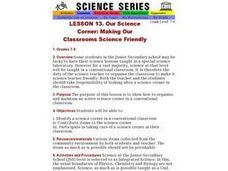Curated OER
Factoring Trinomials
Learners factor trinomials using patterns and their TI to graph their results and make predictions through this lesson. This is accomplished by solving quadratic equations through FOIL and algebra tiles.
Curated OER
How Many Days Are in a Year?
Students create a calendar for an imaginary planet. In this earth science instructional activity, students analyze the errors on the different calendars used on Earth. They present their work in class.
Curated OER
Particle Man and the Photon
Learners simulate photon transmission, scattering and absorption. In this physics lesson, students explain why some objects appear bright while others appear dark. They define photon and radiation in their own words.
Curated OER
Our Science Corner: Making Our Classrooms Science Friendly
Students prepare and care for a classroom science corner. In this science lesson, students contritubute items to the classroom science corner, and invite other classes of students into their room to share their scientific items.
Curated OER
Our Important Wetlands and Uplands
Students define wetlands. They list the benefits wetlans provide to man and nature. They compare types of wetlands that exist in northeast or east-central Florida. They list ways uplands affect wetlands and other water bodies.
Curated OER
de Soto's Expedition: An Alternate Route
Eighth graders interpret historical evidence presented in primary and secondary resources. In this Exploration Age lesson, 8th graders compare historical maps with new maps focusing on the route of Hernado de Soto.
Curated OER
Understanding Interactions Among Local Species and the Local Environment
Students examine the differences between biotic and abiotic factors, explain the difference between habitat and niche and compare how organisms get their nutritional needs. In this local environment lesson students trace the path...
Curated OER
Finding Patterns and Graphing Functions
Pupils investigate patters for area and perimeter. In this Algebra I/Geometry lesson, students explore two different patterns as they write a formula for the nth term of each pattern. Pupils graph their results and determine if the...
Curated OER
Finding a Line of Best Fit
Pupils engage in the practice of creating a scatter plot with the data obtained from measuring different resting heart rates. The data is used to create the table that is translated into a graph. The lesson plan gives instructions for...
Curated OER
Handy Reflections
Learners explore reflections on a coordinate plane in this lesson. They trace their hand on a grid, determine the coordinates of each point, and create a scatter plot of their points. Pupils use this information to investigate aspect...
Curated OER
Delivering Service
Pupils explore the term consensus. In this vocabulary lesson, students define consensus and discuss how and why people make decisions this way. Pupils also practice reaching a consensus on which classmate should receive the classroom...
Curated OER
The Factor Connection
Pupils investigate the connection between factors, zeros, and graphs of quadratic functions. The lesson requires the TI-nspire handheld.
Curated OER
Trains in Motion
Students compare two object as they find the distance between them. For this geometry lesson, students create an equation describing the distance of time as a function. They use the navigator to observe the distance.
Curated OER
Medieval Ethiopia, Mali and Nigeria: The Influence of Culture in Africa
Students are introduced to the concept of cultural diffusion. In groups, they identify the culture of Mali, Nigeria and Ethiopia and work together to research how cultural diffusion has changed the country. To end the lesson, they...
Curated OER
What Would We Do?
Students develop an emergency plan for their pets. In this animal welfare lesson plan, students discuss how to keep their pets safe in an emergency and create pet emergency kits.
Curated OER
Junkyard Wars: Air Movers
Students study Rube Goldberg machines. In this investigative lesson students design and build a machine that uses several steps to move an aluminum can.
Curated OER
Why Plants Are Important to Us
First graders explore plant life. In this plant lesson, 1st graders examine various plant life and categorize them. Students graph their data and make journal entries regarding their work.
Curated OER
Total Daily Calories
Students explore the concept of calories. For this calories lesson, students calculate their Basal Metabolic Rate. Students determine the number of calories they burn each day. Students use a conversion factor of fat to calories to...
Curated OER
Responsibility in the Classroom
Students study responsible behavior. In this behavior lesson, students discuss ways friends show responsibility. Students take turns selecting a card about responsible behavior and describe the card's behavior. Students make a list of...
Curated OER
AMERICAN INVOLVEMENT IN WORLD WAR II: THE PACIFIC THEATER 1941-1945
Tenth graders describe roles of key figures in the Pacific Theater of war during World War II. In this American History lesson plan, 10th graders research key events of the Pacific Theater of War during World War II. Students...
Curated OER
The Gulf War 1990-1991
High schoolers examine facets of the Gulf War. In this Gulf War lesson, students review vocabulary and people related to the war. High schoolers then research various Gulf War Topics in heterogeneous groups. Students share their findings...
Curated OER
Guidelines for Recognizing Persuasiveness, Propaganda, and Stereotypes
Students investigate advertisements for examples of persuasiveness, propaganda, and stereotypes. In this persuasion instructional activity, students find examples of advertisements that are unusual or common. Students discuss...
Curated OER
Context Clues
Students develop vocabulary using pre -reading strategies. In this language arts instructional activity, students discuss the intended message from observing a picture. Additionally, students explore guessing the covered word within a text.
Curated OER
Are Cellphones Killing Honeybees?
Students read an article about how honeybee are sensitive to the electromagnetic fields generated by cellphones. In this ESL activity, students work as partners to complete a table of information relating to the many bee species in...























